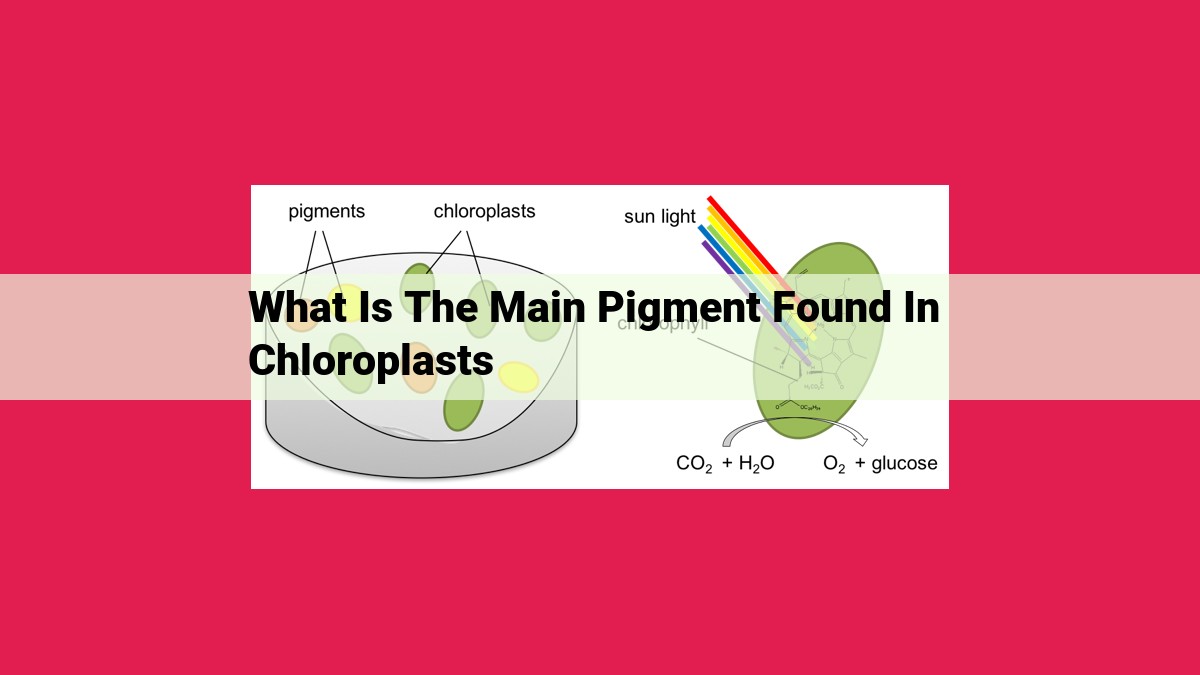Chlorophyll: The Essential Pigment For Plant Life And Ecosystem Vitality

Chlorophyll, the primary pigment in chloroplasts, is essential for photosynthesis, capturing sunlight to convert it into chemical energy. Comprising chlorophyll a and b, it absorbs specific light wavelengths. Accessory pigments, such as carotenoids and xanthophylls, enhance absorption by capturing different wavelengths and transferring energy to chlorophyll. Together, these pigments enable chloroplasts to maximize sunlight absorption for photosynthesis, the process that sustains plant life and the global ecosystem.
The Power of Chloroplasts: The Unsung Heroes of Life
In the realm of plant life, there exists a hidden world of miniature powerhouses known as chloroplasts. These organelles, often likened to the solar panels of the plant cell, hold the key to life on Earth as we know it. Their primary function is photosynthesis, the remarkable process by which sunlight is transformed into chemical energy.
Within the intricate network of chloroplasts, chlorophyll reigns supreme. This pigment is the maestro of photosynthesis, responsible for absorbing the light that fuels the entire process. Like a conductor leading an orchestra, chlorophyll sets the stage for the conversion of sunlight into chemical energy.
Chlorophyll: The Essential Pigment
In the mesmerizing tapestry of nature, chlorophyll holds a pivotal role, empowering plants with the extraordinary ability to transform sunlight into life-sustaining energy. Acting as the driving force behind photosynthesis, this verdant pigment is the cornerstone of the intricate ecosystem that sustains our planet.
Chlorophyll, a complex molecule, boasts a remarkable structure. Its flat, porphyrin head contains a magnesium ion, while its hydrophobic tail, composed of a long carbon chain, anchors it within the thylakoid membranes of chloroplasts. Within chloroplasts, two primary forms of chlorophyll reside: chlorophyll a and chlorophyll b.
Chlorophyll a: The predominant form, chlorophyll a, is responsible for the iconic green hue of plants. It absorbs light primarily in the blue and red regions of the spectrum, wavelengths that penetrate foliage most effectively.
Chlorophyll b: A complementary pigment, chlorophyll b, absorbs light in the green and yellow regions of the spectrum. This broader absorption range enhances the overall efficiency of photosynthesis by capturing light that chlorophyll a cannot.
Together, these chlorophyll pigments orchestrate a dynamic dance of light absorption, maximizing the capture of radiant energy that fuels the process of photosynthesis.
Accessory Pigments: The Unsung Heroes of Sunlight Absorption
Step into the enchanting world of photosynthesis, where the dance of light and life unfolds. Amidst the lush green canopy of chloroplasts, tiny molecular wonders work tirelessly to harness the sun’s energy and convert it into the sustenance of all living organisms. Among these unsung heroes are accessory pigments, molecules that stand alongside chlorophyll as guardians of light.
-
Defining Accessory Pigments
- Accessory pigments are the supporting cast of the chloroplast. They assist the star performer, chlorophyll, in capturing more of the sun’s radiant energy.
-
Types of Accessory Pigments
- Carotenoids, with their vibrant orange and yellow hues, are the most abundant accessory pigments. They excel at absorbing blue and green light, enhancing chlorophyll’s ability to capture red and blue light.
- Xanthophylls, like autumn foliage, display a kaleidoscope of colors from yellow to orange. They assist carotenoids in absorbing blue and green light, adding to the diversity of wavelengths harnessed by the chloroplast.
-
Light Absorption and Energy Transfer
- Accessory pigments, with their unique molecular structures, are tuned to absorb specific wavelengths of light. They act as gatekeepers, capturing light that chlorophyll might miss.
- Once absorbed, they swiftly transfer this energy to chlorophyll, increasing the overall efficiency of light absorption.
By working in concert, chlorophyll and accessory pigments create a symphony of light absorption. They maximize the capture of sunlight, providing the chloroplast with the energy it needs to fuel photosynthesis and sustain the vibrant tapestry of life on Earth.
The Synergistic Dance of Chlorophyll and Accessory Pigments in Photosynthesis
Within the heart of plant cells, a remarkable partnership unfolds. Chlorophyll, the primary pigment responsible for photosynthesis, teams up with a symphony of accessory pigments to orchestrate the vital conversion of sunlight into life-sustaining energy. These pigments work in tandem, creating a synergistic relationship that empowers plants to thrive and nourish the entire ecosystem.
Chlorophyll: The Maestro of Light Absorption
Chlorophyll is a complex molecule adorned with a porphyrin ring that houses a central magnesium atom. It acts as the maestro of photosynthesis, its molecular structure perfectly attuned to capture the energy of sunlight. Within the chloroplasts, the organelles that house photosynthesis, chlorophyll resides in stacked membranes known as thylakoids.
Accessory Pigments: The Supporting Ensemble
While chlorophyll plays a starring role in the photosynthetic drama, it cannot work alone. Here’s where the ensemble of accessory pigments enters the stage. These molecules, including carotenoids and xanthophylls, possess different molecular structures that enable them to absorb a wider range of wavelengths than chlorophyll alone.
The Harmonious Union
Chlorophyll and accessory pigments work together seamlessly, forming a photosynthetic ensemble. Accessory pigments, such as carotenoids, act as “light gatherers,” capturing wavelengths that chlorophyll misses. Like a symphony orchestra, they pass this captured energy to chlorophyll, which then funnels it into the photosynthetic electron transport chain.
This electron transport chain is the heart of photosynthesis, where the captured light energy is harnessed to generate ATP, the energy currency of the cell, and NADPH, a reducing agent. Together, ATP and NADPH provide the driving force for the production of glucose, the life-sustaining sugar that fuels plant growth and nourishes the food chain.
In conclusion, chlorophyll and accessory pigments are the dynamic duo of photosynthesis. Their synergistic relationship amplifies light absorption, maximizing energy conversion and ensuring the continued prosperity of plant life on our planet. Without this harmonious partnership, the very foundation of our ecosystem would crumble, leaving us in a world devoid of sustenance and devoid of the vibrant tapestry of life we cherish.